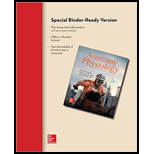
Combo: Loose Leaf Version of Anatomy & Physiology: An Integrative Approach with Connect Access Card
2nd Edition
ISBN: 9781259385148
Author: Michael McKinley Dr., Valerie O'Loughlin, Theresa Bidle
Publisher: McGraw-Hill Education
expand_more
expand_more
format_list_bulleted
Question
Chapter 15, Problem 16DYKB
Summary Introduction
To describe:
The difference between antagonistic effects and cooperative effects in dual innervation of the target organs.
Concept introduction:
Many organs are innervated by both the divisions of the ANS (autonomic nervous system); parasympathetic as well as sympathetic. There are various effectors that possess dual innervation. It means that the effectors are innervated by axons (postganglionic) from both the sympathetic as well as the parasympathetic divisions.
Expert Solution & Answer
Want to see the full answer?
Check out a sample textbook solution
Students have asked these similar questions
Describe the differences between cooperative effects and antagonistic effects in dual innervation of target organs.
Define the term reciprocal innervation?
Using the cardiovascular, respiratory and digestive systems as examples, explain how dual innervation regulates the function of each system.
Chapter 15 Solutions
Combo: Loose Leaf Version of Anatomy & Physiology: An Integrative Approach with Connect Access Card
Ch. 15.1 - What criterion is used to organize the nervous...Ch. 15.1 - Prob. 2WDYLCh. 15.1 - What CNS structure is the integration and command...Ch. 15.2 - Prob. 4WDYLCh. 15.2 - Describe the general anatomic differences in the...Ch. 15.2 - Prob. 6WDYLCh. 15.3 - Which four cranial nerves have a parasympathetic...Ch. 15.3 - What organs are innervated by the pelvic...Ch. 15.4 - Prob. 9WDYLCh. 15.4 - Prob. 10WDYL
Ch. 15.4 - Prob. 11WDYLCh. 15.4 - In what ways does the adrenal medulla pathway help...Ch. 15.5 - Prob. 13WDYLCh. 15.5 - Prob. 14WDYLCh. 15.5 - Prob. 15WDYLCh. 15.5 - Prob. 16WDYLCh. 15.5 - Prob. 17WDYLCh. 15.6 - Prob. 18WDYLCh. 15.6 - Prob. 19WDYLCh. 15.6 - Prob. 20WDYLCh. 15.6 - What are the body structures innervated by the...Ch. 15.7 - Prob. 22WDYLCh. 15.7 - Prob. 23WDYLCh. 15 - A splanchnic nerve in the sympathetic division of...Ch. 15 - Some parasympathetic preganglionic neuron cell...Ch. 15 - Prob. 3DYKBCh. 15 - Prob. 4DYKBCh. 15 - Sympathetic division preganglionic axons travel to...Ch. 15 - Prob. 6DYKBCh. 15 - Prob. 7DYKBCh. 15 - A sympathetic postganglionic axon is a. long and...Ch. 15 - Prob. 9DYKBCh. 15 - Prob. 10DYKBCh. 15 - Prob. 11DYKBCh. 15 - For the following ganglia, identify the location...Ch. 15 - Prob. 13DYKBCh. 15 - Prob. 14DYKBCh. 15 - Prob. 15DYKBCh. 15 - Prob. 16DYKBCh. 15 - Prob. 17DYKBCh. 15 - What may occur with the mass activation of the...Ch. 15 - Prob. 19DYKBCh. 15 - Prob. 20DYKBCh. 15 - Prob. 1CALCh. 15 - Arlene was in a heightened state of alertness well...Ch. 15 - George has hypertension (high blood pressure). His...Ch. 15 - Prob. 4CALCh. 15 - Prob. 5CALCh. 15 - Prob. 1CSLCh. 15 - When you were younger, your parents may have told...Ch. 15 - Prob. 3CSL
Knowledge Booster
Similar questions
- How can the sympathetic nervous system have contrasting effects in a target organ without dual innervation?arrow_forwardExplain synergistic vs antagonisticarrow_forwardDescribe the basic pathway of parasympathetic innervation through cranial nerves and sacral spinal nerves to the visceral organs.arrow_forward
- List the effects of sympathoadrenal stimulation on different effector organs. In each case, indicate whether the effect is due to alpha- or beta-receptor stimulation.arrow_forwardOutline the major chemical steps responsible for long-term potentiation.arrow_forwardExplain how ligand-gated channels are opened, using nicotinic ACh receptors as an example.arrow_forward
- Describe the effect of parasympathetic innervation on each visceral organ innervated by the division of the ANS, especially the heart, blood vessels, gastrointestinal tract, lungs, adrenal medulla, and external genitalia.arrow_forwardWhich choice below correctly matches the effector to the effects of sympathetic stimulation? pupils of the eye --> dilates pupils lungs --> constricts air passages heart --> decreases heart rate stomach --> increases activity of stomach urinary bladder --> stimulates urinationarrow_forwardList potential signs and symptoms of impaired intracranial regulation in a patient.arrow_forward
arrow_back_ios
arrow_forward_ios
Recommended textbooks for you
 Human Physiology: From Cells to Systems (MindTap ...BiologyISBN:9781285866932Author:Lauralee SherwoodPublisher:Cengage Learning
Human Physiology: From Cells to Systems (MindTap ...BiologyISBN:9781285866932Author:Lauralee SherwoodPublisher:Cengage Learning

Human Physiology: From Cells to Systems (MindTap ...
Biology
ISBN:9781285866932
Author:Lauralee Sherwood
Publisher:Cengage Learning